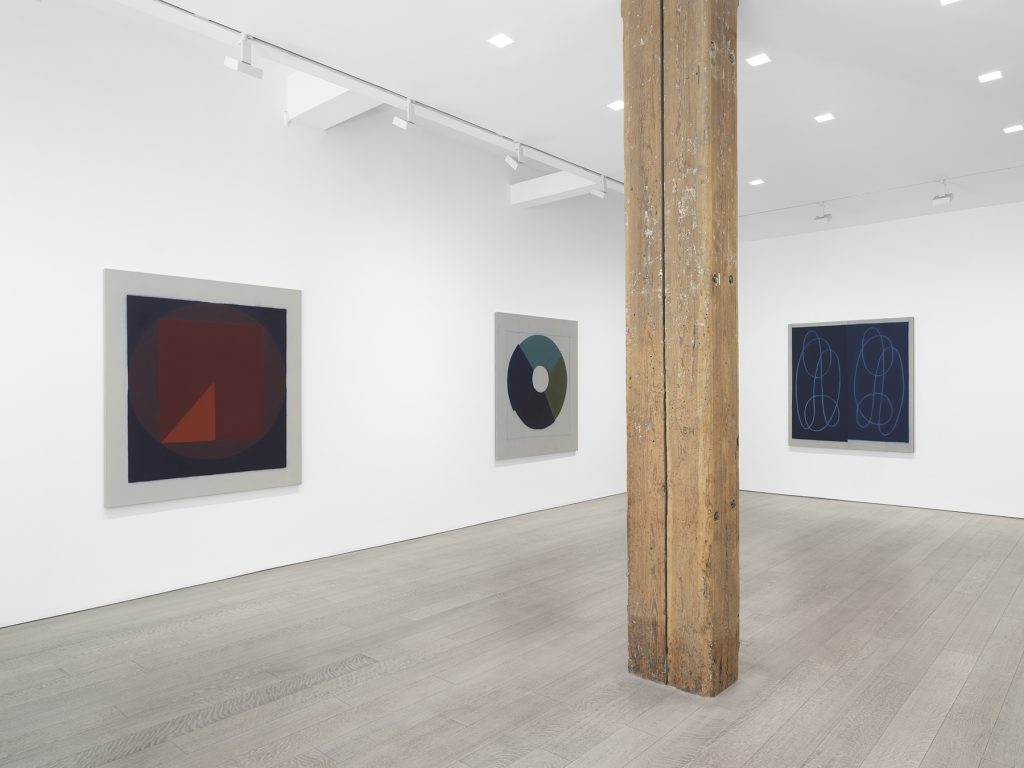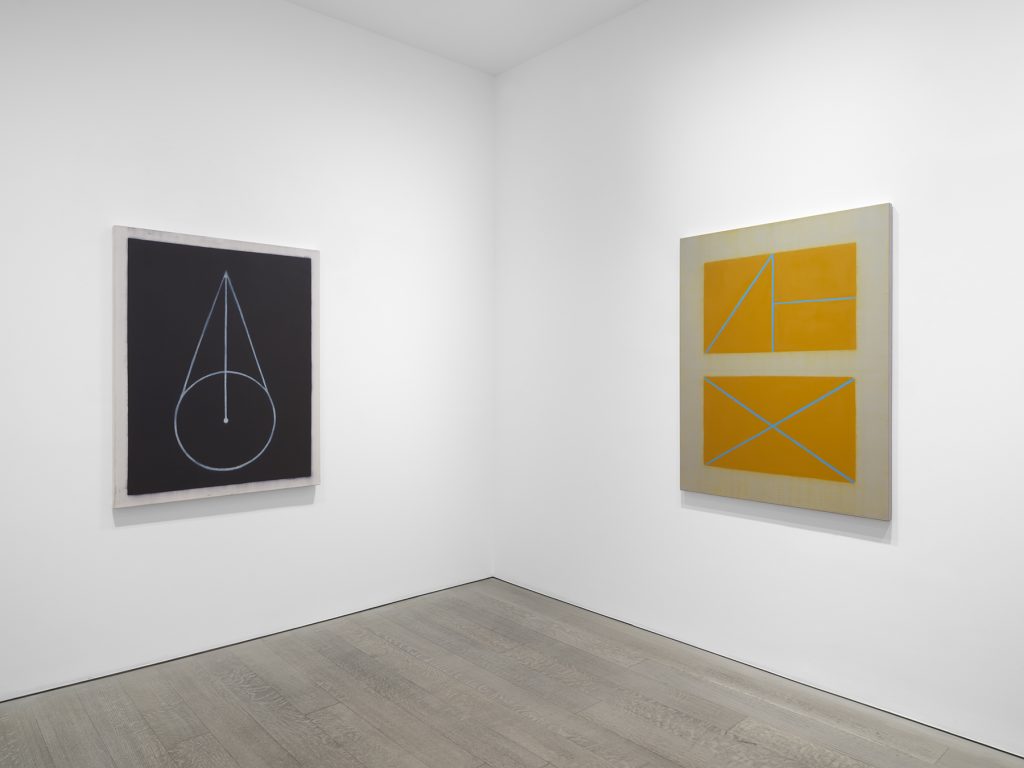Suzanne Caporael’s artwork is very memorable.
The Textures of Caporael’s “Proof”
Caporael’s paintings in “Proof,” a new exhibition at Miles McEnery Gallery in New York City, use oil on linen, and Caporael’s particular method of applying color lets the gentle but shimmering texture of the underlying linen really shine through.
While Caporael’s abstract forms assembled in each of these artworks are fully and forcefully realized via imperceptible brushstrokes blending into something about as solid as a two-dimensional creation can be, she leaves the linen’s texture visible. Though oil paint can easily end up rising quite prominently from an artwork’s surface, Caporael’s layers of color are thinner.
And these textural elements — the particular features of the materials that Caporael was utilizing that she brought to the surface and spotlighted — enforce a sheen of serenity across the exhibition. The paintings — abstract works, with included references to mathematics — are grounded, evoking, for me, even the textures of the natural world. It’s a quietly enveloping immersion on par with, perhaps, stepping into a grassy field and sensing the reaching plants.
And the particular textural richness that Caporael cultivated across the paintings in this exhibition (and in others from her career) adds incredible depth to each individual painting’s experience, enlivening the conceptual space behind the image itself in which the various components join together and pushing the colors outward, towards the painting’s viewer. Rather than, say, a moment of visual illusion or an ask for suspension of disbelief, the textured colors lean into relationships with each other — and you.

Color and Space
Caporael’s specific colors create a similar effect. There’s a repeating olive green, for instance, which still carries the sense of refreshment and possibility of lighter greens but feels more weighted.
It’s not as though darkness completely fell already in the world these paintings evoke — but it’s getting there. And for now, the assemblages of color and shape linger amid sunset, a time of day when — if you catch the right moment — you can sense the day’s retreat but see serene majesty from the enrapturing colors.
One example from Caporael, “No. 773” (2023), features sunny circles of joined together triangles of orange, yellow, and a lighter green — but here, those shapes are essentially swallowed up by the grayish background, which is populated in turn by a subtle architecture of sweeping, forceful lines in which the smaller shapes sit. Some of the color from the smaller forms also hazily extends into that visual backdrop. And though the color pops, you’re ultimately returned to a reassuring, supportive sense of stability.
In each painting, as Caporael varies the size, color, and spatial relationships of her forms, there’s another consistent feature: space. She uses borders outside the central visuals of some paintings to further that space, and in the central images, even when Caporael’s colorful but heavy tones are packed together like Tetris bricks on the linen’s surface, a relaxed sense of order seems to dominate, cultivating a kind of conceptually open space within the painting’s imagery.

Illuminating Order
The order — whether more glaring or a bit further from the viewer but still apparent, when forms interact with each other in a more complicated but still forward moving fashion — suggests a system at work.
Caporael’s paintings build atop themselves with forms that you can’t help but sense are going someplace — fulfilling some specific purpose, even if precision is elusive. Where the late Ellsworth Kelly’s uniquely shaped paintings reflected bits of form from the natural world and elevated those pieces of visual linguistics to a staggeringly full extent, Caporael, I feel, puts her forms in motion, spotlighting spirals of growth.
At a foundational level, because of the relationships and progressions in which Caporael was embedding them, the forms appearing across her paintings felt less like something strictly abstract and more like plucked bits of shape and substance from real-world environments. The visual correlations weren’t super direct, but the two sides — Caporael’s paintings and lived-in environments — still connected, though the systems that Caporael was crafting came across as also reflecting whatever sits behind the bare, logistical specifics of space and whatever occupies it.
The forms maintained a distinctly ordered, progressing character, but in remaining outside a precise categorization, they allowed for broader interpretation.
The most direct reference point for some of Caporael’s specific shapes was apparently straightforward geometry. Tangled lines appearing in “No. 794” (2024) correlated directly to knot theory, an intriguing branch of mathematics.
I’m not particularly well versed in mathematics, but Caporael’s paintings — even without having that knowledge — point towards the mathematical order that explains how our world, as beset with interpersonal and social hurdles as it is, remains physically operational — a marvel, arguably! In varying specific guises, the artwork reflects the progressions of our bodies and spaces through, for ourselves, space and time, and for fixed environments, just the flow of time.
Considering that, it’s easy to see Caporael’s paintings as inherently hopeful in their charting of forward paths that may lie beyond any precise visual vantage point but are still welcoming.
“Suzanne Caporael: Proof” remains on view through October 26.

Featured image: New York, NY: Miles McEnery Gallery, ‘Suzanne Caporael: Proof,’ 5 September – 26 October 2024. Image: Christopher Burke Studio. Courtesy of the artist and Miles McEnery Gallery, New York, NY
You may also like
-
Diana Kurz at Lincoln Glenn in New York: A Review of a Shining Art Exhibition
-
Dustin Hodges at 15 Orient in New York City: An Ensnaring Exhibition at an Exciting Gallery
-
Maren Hassinger at Susan Inglett Gallery in New York: Reviewing an Uplifting Art Exhibition
-
Enzo Shalom at Bortolami in New York City: Reviewing an Entrancing Exhibition of Paintings
-
“Ben Werther: Townworld” at Amanita in New York City: Reviewing a Richly Memorable Art Exhibition
